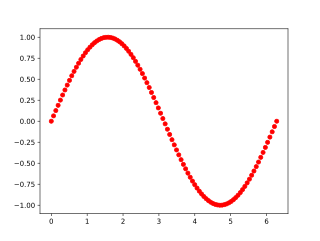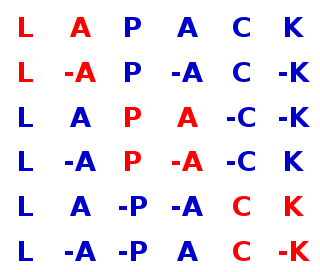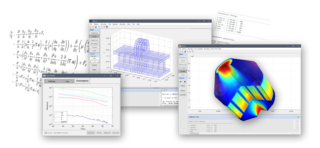Related Research Articles

Numerical analysis is the study of algorithms that use numerical approximation for the problems of mathematical analysis. It is the study of numerical methods that attempt to find approximate solutions of problems rather than the exact ones. Numerical analysis finds application in all fields of engineering and the physical sciences, and in the 21st century also the life and social sciences, medicine, business and even the arts. Current growth in computing power has enabled the use of more complex numerical analysis, providing detailed and realistic mathematical models in science and engineering. Examples of numerical analysis include: ordinary differential equations as found in celestial mechanics, numerical linear algebra in data analysis, and stochastic differential equations and Markov chains for simulating living cells in medicine and biology.

Maple is a symbolic and numeric computing environment as well as a multi-paradigm programming language. It covers several areas of technical computing, such as symbolic mathematics, numerical analysis, data processing, visualization, and others. A toolbox, MapleSim, adds functionality for multidomain physical modeling and code generation.

SciPy is a free and open-source Python library used for scientific computing and technical computing.

NumPy is a library for the Python programming language, adding support for large, multi-dimensional arrays and matrices, along with a large collection of high-level mathematical functions to operate on these arrays. The predecessor of NumPy, Numeric, was originally created by Jim Hugunin with contributions from several other developers. In 2005, Travis Oliphant created NumPy by incorporating features of the competing Numarray into Numeric, with extensive modifications. NumPy is open-source software and has many contributors. NumPy is a NumFOCUS fiscally sponsored project.

LAPACK is a standard software library for numerical linear algebra. It provides routines for solving systems of linear equations and linear least squares, eigenvalue problems, and singular value decomposition. It also includes routines to implement the associated matrix factorizations such as LU, QR, Cholesky and Schur decomposition. LAPACK was originally written in FORTRAN 77, but moved to Fortran 90 in version 3.2 (2008). The routines handle both real and complex matrices in both single and double precision. LAPACK relies on an underlying BLAS implementation to provide efficient and portable computational building blocks for its routines.
Basic Linear Algebra Subprograms (BLAS) is a specification that prescribes a set of low-level routines for performing common linear algebra operations such as vector addition, scalar multiplication, dot products, linear combinations, and matrix multiplication. They are the de facto standard low-level routines for linear algebra libraries; the routines have bindings for both C and Fortran. Although the BLAS specification is general, BLAS implementations are often optimized for speed on a particular machine, so using them can bring substantial performance benefits. BLAS implementations will take advantage of special floating point hardware such as vector registers or SIMD instructions.
Computational science, also known as scientific computing, technical computing or scientific computation (SC), is a division of science that uses advanced computing capabilities to understand and solve complex physical problems. This includes
ScientificPython is an open source library of scientific tools for the Python programming language. Its development started in 1995.
Numerical linear algebra, sometimes called applied linear algebra, is the study of how matrix operations can be used to create computer algorithms which efficiently and accurately provide approximate answers to questions in continuous mathematics. It is a subfield of numerical analysis, and a type of linear algebra. Computers use floating-point arithmetic and cannot exactly represent irrational data, so when a computer algorithm is applied to a matrix of data, it can sometimes increase the difference between a number stored in the computer and the true number that it is an approximation of. Numerical linear algebra uses properties of vectors and matrices to develop computer algorithms that minimize the error introduced by the computer, and is also concerned with ensuring that the algorithm is as efficient as possible.

Computational Engineering is an emerging discipline that deals with the development and application of computational models for engineering, known as Computational Engineering Models or CEM. Computational engineering uses computers to solve engineering design problems important to a variety of industries. At this time, various different approaches are summarized under the term Computational Engineering, including using computational geometry and virtual design for engineering tasks, often coupled with a simulation-driven approach In Computational Engineering, algorithms solve mathematical and logical models that describe engineering challenges, sometimes coupled with some aspect of AI, specifically Reinforcement Learning.
In computer programming, a scientific programming language can refer to two degrees of the same concept.

The FEniCS Project is a collection of free and open-source software components with the common goal to enable automated solution of differential equations. The components provide scientific computing tools for working with computational meshes, finite-element variational formulations of ordinary and partial differential equations, and numerical linear algebra.
Model order reduction (MOR) is a technique for reducing the computational complexity of mathematical models in numerical simulations. As such it is closely related to the concept of metamodeling, with applications in all areas of mathematical modelling.

FEATool Multiphysics is a physics, finite element analysis (FEA), and partial differential equation (PDE) simulation toolbox. FEATool Multiphysics features the ability to model fully coupled heat transfer, fluid dynamics, chemical engineering, structural mechanics, fluid-structure interaction (FSI), electromagnetics, as well as user-defined and custom PDE problems in 1D, 2D (axisymmetry), or 3D, all within a graphical user interface (GUI) or optionally as script files. FEATool has been employed and used in academic research, teaching, and industrial engineering simulation contexts.
References
- ↑ Quarteroni, A., Saleri, F., & Gervasio, P. (2006). Scientific computing with MATLAB and Octave. Berlin: Springer.
- ↑ Gander, W., & Hrebicek, J. (Eds.). (2011). Solving problems in scientific computing using Maple and Matlab®. Springer Science & Business Media.
- ↑ Barnes, B., & Fulford, G. R. (2011). Mathematical modelling with case studies: a differential equations approach using Maple and MATLAB. Chapman and Hall/CRC.
- ↑ David Ramel (2018-05-08). "Open Source, Cross-Platform ML.NET Simplifies Machine Learning -- Visual Studio Magazine". Visual Studio Magazine. Retrieved 2018-05-10.
- ↑ Kareem Anderson (2017-05-09). "Microsoft debuts ML.NET cross-platform machine learning framework". On MSFT. Retrieved 2018-05-10.
- ↑ Bunks, C., Chancelier, J. P., Delebecque, F., Goursat, M., Nikoukhah, R., & Steer, S. (2012). Engineering and scientific computing with Scilab. Springer Science & Business Media.
- ↑ Thanki, R. M., & Kothari, A. M. (2019). Digital image processing using SCILAB. Springer International Publishing.
- ↑ Maeder, R. E. (1991). Programming in mathematica. Addison-Wesley Longman Publishing Co., Inc.
- ↑ Stephen Wolfram. (1999). The MATHEMATICA® book, version 4. Cambridge University Press.
- ↑ Shaw, W. T., & Tigg, J. (1993). Applied Mathematica: getting started, getting it done. Addison-Wesley Longman Publishing Co., Inc.
- ↑ Marasco, A., & Romano, A. (2001). Scientific Computing with Mathematica: Mathematical Problems for Ordinary Differential Equations; with a CD-ROM. Springer Science & Business Media.
- ↑ Zimmermann, P., Casamayou, A., Cohen, N., Connan, G., Dumont, T., Fousse, L., ... & Bray, E. (2018). Computational Mathematics with SageMath. SIAM.
- ↑ Wagner III, W. E. (2019). Using IBM® SPSS® statistics for research methods and social science statistics. Sage Publications.
- ↑ Pollock III, P. H., & Edwards, B. C. (2019). An IBM® SPSS® Companion to Political Analysis. Cq Press.
- ↑ Babbie, E., Wagner III, W. E., & Zaino, J. (2018). Adventures in social research: Data analysis using IBM SPSS statistics. Sage Publications.
- ↑ Aldrich, J. O. (2018). Using IBM® SPSS® Statistics: An interactive hands-on approach. Sage Publications.
- ↑ Stehlik-Barry, K., & Babinec, A. J. (2017). Data Analysis with IBM SPSS Statistics. Packt Publishing Ltd.
- ↑ Ch Scientific Numerical Computing
- ↑ Bezanson, J., Edelman, A., Karpinski, S., & Shah, V. B. (2017). Julia: A fresh approach to numerical computing. SIAM Review, 59(1), 65-98.
- ↑ Bezanson, J., Karpinski, S., Shah, V. B., & Edelman, A. (2012). Julia: A fast dynamic language for technical computing. arXiv preprint arXiv:1209.5145.
- ↑ Gumley, L. E. (2001). Practical IDL programming. Elsevier.
- ↑ Christiansen, T., Wall, L., & Orwant, J. (2012). Programming Perl: Unmatched power for text processing and scripting. " O'Reilly Media, Inc.".
- ↑ Srinivasan, S. (1997). Advanced perl programming. " O'Reilly Media, Inc.".
- ↑ Van Rossum, G. (2007, June). Python Programming Language. In USENIX annual technical conference (Vol. 41, p. 36).
- ↑ Sanner, M. F. (1999). Python: a programming language for software integration and development. J Mol Graph Model, 17(1), 57-61.
- ↑ Jones, E., Oliphant, T., & Peterson, P. (2001). SciPy: Open source scientific tools for Python.
- ↑ Bressert, E. (2012). SciPy and NumPy: an overview for developers. " O'Reilly Media, Inc.".
- ↑ Blanco-Silva, F. J. (2013). Learning SciPy for numerical and scientific computing. Packt Publishing Ltd.
- ↑ Ihaka, R., & Gentleman, R. (1996). R: a language for data analysis and graphics. Journal of computational and graphical statistics, 5(3), 299-314.
- ↑ Khattree, R., & Naik, D. N. (2018). Applied multivariate statistics with SAS software. SAS Institute Inc.
- ↑ SAS/IML